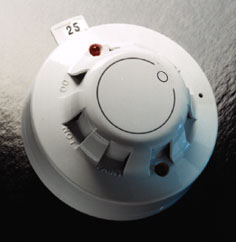All carbon-based
materials in the smouldering, red ember stage of a fire can
produce significant and easily detectable levels of carbon
monoxide (CO). These levels can, therefore, be monitored in
order to give an early warning of a fire.CO
fire detectors are not to be confused with CO detectors which
are used to protect people against carbon monoxide poisoning.
Exposure to CO at concentrations above 300 parts per million (ppm)
can be lethal, causing death within minutes. Apollo do not
produce this type of CO detector.
By contrast, CO fire detectors are electronic detectors
that can indicate the outbreak of a fire by sensing the level
of CO in the air. These detectors have an electrochemical cell
which senses CO but not smoke or any other combustion products.
CO fire
detectors are effective for only certain types of fire such as
deep-seated, smouldering fires. Smoke detectors, however, will
almost always give a better response to a fire that produces a
rising plume of smoke.
After
extensive tests, Apollo has concluded that a multisensor
detector, using smoke and heat sensors, can offer a big
reduction in false alarms compared with simple smoke detectors.
At the same time, the multisensor can out perform the CO fire
detector for most common fire types.
The BFPSA
has issued guidelines for the use of CO detecors. To find
out more, visit their website at
www.bfpsa.org.uk.
CO detectors
are useful in certain well-defined circumstances. Apollo
manufacturers a CO detector as part of the
Discovery
range.
Click
here
for related and product literature.
|
 |
|